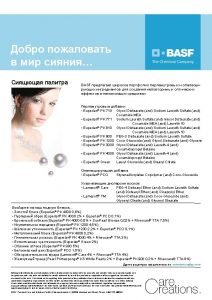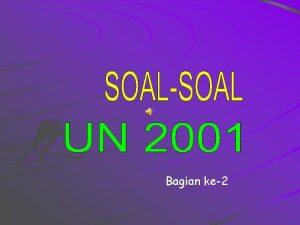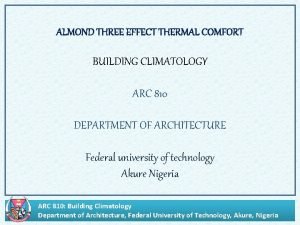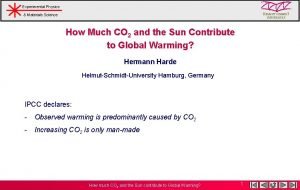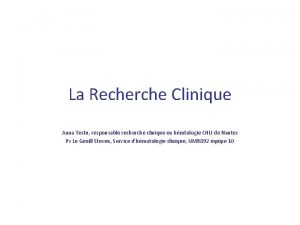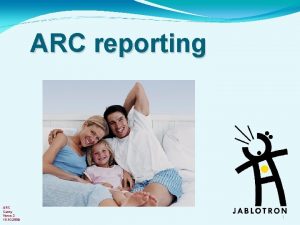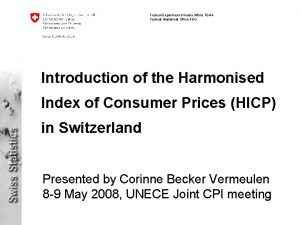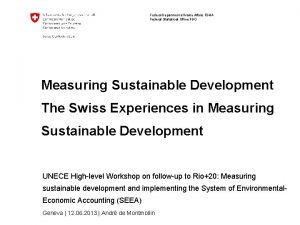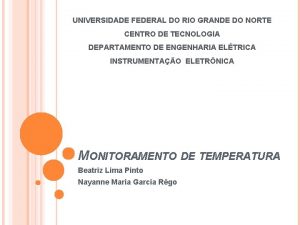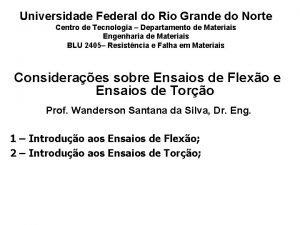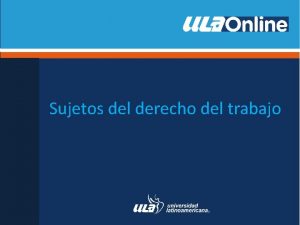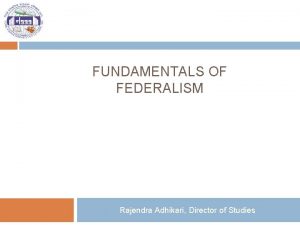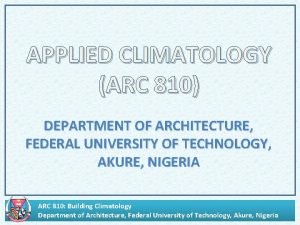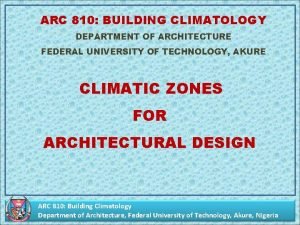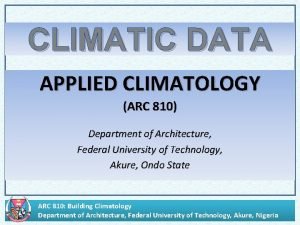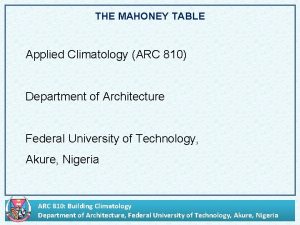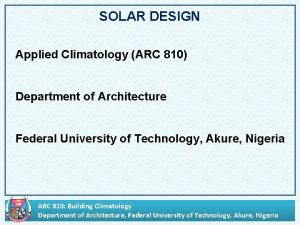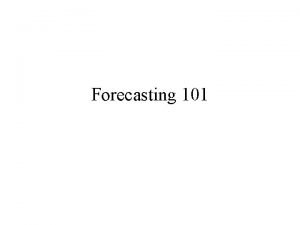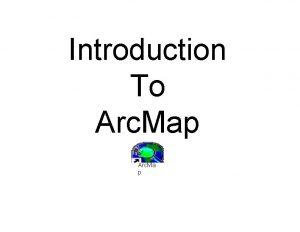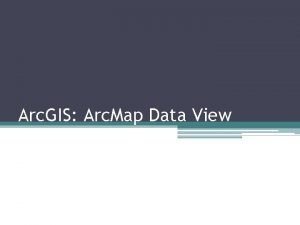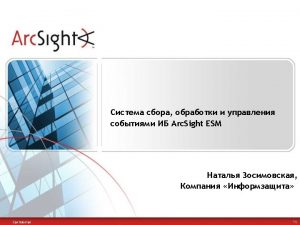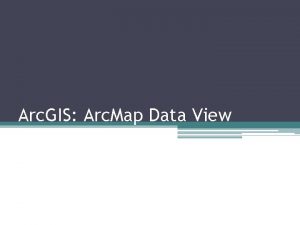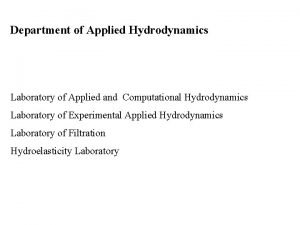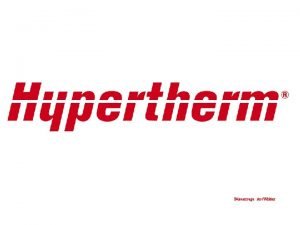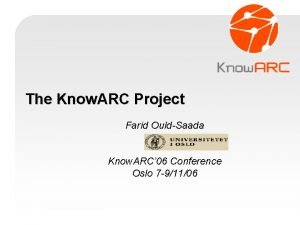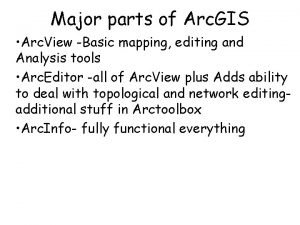APPLIED CLIMATOLOGY ARC 810 DEPARTMENT OF ARCHITECTURE FEDERAL















































- Slides: 47

APPLIED CLIMATOLOGY (ARC 810) DEPARTMENT OF ARCHITECTURE, FEDERAL UNIVERSITY OF TECHNOLOGY, AKURE, NIGERIA ARC 810: Building Climatology Department of Architecture, Federal University of Technology, Akure, Nigeria

. THERMAL COMFORT ARC 810: Building Climatology Department of Architecture, Federal University of Technology, Akure, Nigeria

1. Introduction. 2. Basic concepts of thermal comfort. 3. Thermal balance of the human body. 4. Factors affecting thermal comfort. 5. The thermal indices. 6. Applicability of the indices. 6. Tests and Exercises. ARC 810: Building Climatology Department of Architecture, Federal University of Technology, Akure, Nigeria

1. Introduction Knowledge of the nature of comfort is essential in design with climate. The human body maintains a thermal balance by controlling heat loss and gain. The six major factors that affect comfort are the air temperature, the mean radiant temperature, the air velocity, the relative humidity, the intrinsic clothing and the level of activity. ARC 810: Building Climatology Department of Architecture, Federal University of Technology, Akure, Nigeria

. Thermal indices indicate the simultaneous effect of these six variables on comfort. Such indices include the Standard Effective Temperature (SET), The Effective Temperature (ET), The Corrected Effective Temperature (CET), The Resultant Temperature (RT), The Heat Stress Index (HSI), The Equivalent Warmth (EW), ARC 810: Building Climatology Department of Architecture, Federal University of Technology, Akure, Nigeria

. The Equatorial Comfort Index (ECI), The Predicted Four Hour Sweat Rate (P 4 SR), The Operative Temperature (OT), The Index of Thermal Stress (ITS), The Bioclimatic Chart, The Mahoney Scale and the Evans Scale. Only some of these indices may be applicable in Nigerian conditions. ARC 810: Building Climatology Department of Architecture, Federal University of Technology, Akure, Nigeria

2. Basic Concepts of Thermal. Comfort. The aim of design with climate is to maintain comfort within buildings. An analysis is usually carried out to ascertain how these external conditions compare with the required conditions. It is essential in this respect to define the limits within which people are likely to feel comfortable. ARC 810: Building Climatology Department of Architecture, Federal University of Technology, Akure, Nigeria

3. Thermal Balance of the Human Body The body gets energy from digestion of food through metabolism, that is the processes involved in converting foodstuff into living matter and energy. There are two types of metabolism: 1. Basal metabolism, 2. Muscular metabolism. ARC 810: Building Climatology Department of Architecture, Federal University of Technology, Akure, Nigeria

. In order to maintain a constant deep body temperature and thermal balance, the total heat gained must be equal to the total heat lost. See figure 1. Figure 1: Thermal balance of the human body. ARC 810: Building Climatology Department of Architecture, Federal University of Technology, Akure, Nigeria

. There are mechanisms for controlling heat loss both inside and outside the body. These include Sweating, Shivering, and Breathing. Control is maintained externally by Clothing, Activity rate, Posture and Choice of location. These are individual voluntary control mechanisms. See figures 2 and 3. The physical built environment can also affect thermal environment, thereby contributing to the control of body temperature. ARC 810: Building Climatology Department of Architecture, Federal University of Technology, Akure, Nigeria

Figure 2: Thermal control for the human body. Figure 3: Thermal control for the human body. ARC 810: Building Climatology Department of Architecture, Federal University of Technology, Akure, Nigeria

4. Factors Affecting Thermal. Comfort There are six major factors which affect thermal comfort. They are: 1. The air temperature 2. The mean radiant temperature 3. The air velocity 4. The relative humidity 5. The intrinsic clothing 6. The level of activity ARC 810: Building Climatology Department of Architecture, Federal University of Technology, Akure, Nigeria

. The first four are factors of thermal environment. Apart from these major factors, there are several others that may have an effect on the sensation of comfort. These include age, sex, acclimatisation, body shape and health. ARC 810: Building Climatology Department of Architecture, Federal University of Technology, Akure, Nigeria

‘ The air temperature, that is the dry bulb temperature is a very important factor affecting thermal comfort. When temperatures are low, people feel cold and when they are high people feel hot. Comfort can approximately be achieved between 16 and 28 degrees Celsius. ARC 810: Building Climatology Department of Architecture, Federal University of Technology, Akure, Nigeria

. The Mean Radiant Temperature This refers usually to radiation to and from surfaces within an enclosure measured with the globe thermometer. Comfort can be achieved if the globe temperature is between 16 and 28 degrees Celsius and if the difference between the mean radiant temperature and the dry bulb temperature is less than 5 degrees Celsius. ARC 810: Building Climatology Department of Architecture, Federal University of Technology, Akure, Nigeria

. Air Velocity Air movement is very effective in increasing heat loss from the body at high temperatures when sweating occurs. The air movement enhances the evaporation of sweat from the body thereby cooling down the body. Air velocity of up to 0. 1 metre per second may lead to a feeling of stuffiness indoors. ARC 810: Building Climatology Department of Architecture, Federal University of Technology, Akure, Nigeria

. The Relative Humidity When there is low humidity the air is very dry and sweating is more effective in cooling down the body. However, when the humidity is high the air is damp and clammy and sweating is no longer very effective in cooling down the body. Thermal comfort can be achieved when the relative humidity is between 20 and 90%. ARC 810: Building Climatology Department of Architecture, Federal University of Technology, Akure, Nigeria

. The Intrinsic Clothing is measured in clo units: 0. 5 clo => a pair of shorts for men and a cotton dress for women. 1. 0 clo => normal business suit, shirt and underwear 2. 0 clo => outdoor winter clothing. The range of intrinsic clothing for thermal comfort is taken to be from 0. 5 to 1. 0 clo. ARC 810: Building Climatology Department of Architecture, Federal University of Technology, Akure, Nigeria

‘ The activity represents the metabolic rate. The higher the activity, the more heat is produced by the body. The metabolic rate is measured in W/m. The rate for a person sitting is about 58 W/m and this is taken as the basic unit of activity known as the "met". ARC 810: Building Climatology Department of Architecture, Federal University of Technology, Akure, Nigeria

. As such: Sitting = 1 met Sleeping = 0. 7 met Standing relaxed = 1. 2 met Dancing = 2. 4 -4. 4 met Heavy machine work = 3. 5 -4. 5 met Comfort can be maintained with metabolic rates from about 0. 7 to 2. 5 met. ARC 810: Building Climatology Department of Architecture, Federal University of Technology, Akure, Nigeria

4. Thermal Indices. The Standard Effective Temperature (SET). This is a rational physiologically-based index of comfort. It expresses any environment, clothing and activity level in terms of a uniform environment standardised at 50 percent RH, air velocity of 0. 125 m/s, activity of 1 met and intrinsic clothing at 0. 6 clo. See Figure bellow ARC 810: Building Climatology Department of Architecture, Federal University of Technology, Akure, Nigeria

. Figure 4: The kata thermometer ARC 810: Building Climatology Department of Architecture, Federal University of Technology, Akure, Nigeria

The Effective Temperature (ET). . This is the temperature of a still, saturated atmosphere, which would, in the absence of radiation, produce the same effect as the atmosphere in question. It combines the effects of the following: 1. The relative humidity 2. The air velocity 3. The air temperature ARC 810: Building Climatology Department of Architecture, Federal University of Technology, Akure, Nigeria

. Figure 5: Thermal comfort chart for the Standard Effective Temperature index. ARC 810: Building Climatology Department of Architecture, Federal University of Technology, Akure, Nigeria

The Corrected Effective Temperature. This scale is an improvement on the ET scale as it considers radiation effects as a fourth determinant of comfort. ARC 810: Building Climatology Department of Architecture, Federal University of Technology, Akure, Nigeria

. The Resultant Temperature (RT). The Resultant Temperature is an improvement on the ET and the nomograms defining them are almost identical. It was developed in France by Missenard and is considered unreliable for tropical conditions as it does not sufficiently Incorporate the cooling effects of air movement over 35 degrees Celsius and 80 percent RH. See figure 6. ARC 810: Building Climatology Department of Architecture, Federal University of Technology, Akure, Nigeria

. Figure 6: Effective Temperature nomogram for persons wearing normal clothes. ARC 810: Building Climatology Department of Architecture, Federal University of Technology, Akure, Nigeria

The Heat Stress Index (HSI). . The Heat Stress Iindex, which is reliable between 27 and 35 degrees Celsius, 30 and 80 percent RH, takes the metabolic heat production of subjects doing various kinds of work as an indication of heat stress. ARC 810: Building Climatology Department of Architecture, Federal University of Technology, Akure, Nigeria

. The Equivalent Warmth (EW). This scale was developed by Bedford in England is based on the reaction of 2000 factory workers engaged in light work, under varying indoor conditions. It takes into account the air temperature, the RH and the mean radiant temperature. The EW is reliable within the comfort zone up to 35 degrees Celsius with low RH and up to 30 degrees Celsius with high RH. ARC 810: Building Climatology Department of Architecture, Federal University of Technology, Akure, Nigeria

. The Equatorial Comfort Index (ECI). This scale, which is similar to the ET, was developed by Webb in Singapore and it accommodates the effects of temperature, humidity and air movement. ARC 810: Building Climatology Department of Architecture, Federal University of Technology, Akure, Nigeria

The Predicted Four Hour Sweat Rate (P 4 SR). The Operative Temperature (OT). Defined as the uniform temperature of an imaginary enclosure in which man will exchange the same dry heat by radiation and convection as in the actual environment, the OT combines the effects of radiation and air temperature. It was developed by Winslow, Herrington and Gagge, and is similar to the EW. See figure 7. ARC 810: Building Climatology Department of Architecture, Federal University of Technology, Akure, Nigeria

. Figure 7: Chart of the Resultant Temperature index. ARC 810: Building Climatology Department of Architecture, Federal University of Technology, Akure, Nigeria

. The Index Of Thermal Stress (ITS). This is the calculated cooling rate produced by sweating which would maintain thermal balance under the given conditions as established from first principles by Givoni (1976). ARC 810: Building Climatology Department of Architecture, Federal University of Technology, Akure, Nigeria

. Operative Temperature chart. Air velocity = 0. 1 m/s and activity = 1 met. ARC 810: Building Climatology Department of Architecture, Federal University of Technology, Akure, Nigeria

. The Bioclimatic Chart. Victor Olgyay's conviction that there is no point in defining a single-figure index, as each of the components are controllable by different means resulted in the construction of the bioclimatic chart. See figure above. ARC 810: Building Climatology Department of Architecture, Federal University of Technology, Akure, Nigeria

Use of the Bioclimatic Chart. . The bioclimatic chart is popular mainly because of its simplicity of use and the ease with which results can be interpreted for design purposes. For very simple analysis, the average monthly air temperatures and relative humidities may be used. The use of the minima and maxima of these climatic variables is however more informative and this is the procedure described here. ARC 810: Building Climatology Department of Architecture, Federal University of Technology, Akure, Nigeria

Enter Heading Here Figure 9: The bioclimatic chart. ARC 810: Building Climatology Department of Architecture, Federal University of Technology, Akure, Nigeria

. Figure x: Example of the use of the bioclimatic chart for Zaria. ARC 810: Building Climatology Department of Architecture, Federal University of Technology, Akure, Nigeria

. The monthly minima and maxima of air temperature and relative humidity are usually readily available data and are sufficient for this analysis. However, it is advisable to obtain the average monthly wind velocity and mean monthly solar radiation. A reduction factor should be used to convert the wind velocity to air movement at the level of the human body. See table 3. ARC 810: Building Climatology Department of Architecture, Federal University of Technology, Akure, Nigeria

. Table 3: Temperature and humidity limits for different forms of discomfort. ARC 810: Building Climatology Department of Architecture, Federal University of Technology, Akure, Nigeria

. Take the monthly mean minimum temperature and the monthly mean maximum relative humidity for January. These two variables define a point on the Bioclimatic Chart. Take the monthly mean maximum temperature and the monthly mean minimum relative humidity for the same month of January and use this to define a second point. See figure 9. Join these two points together with a straight line. ARC 810: Building Climatology Department of Architecture, Federal University of Technology, Akure, Nigeria

. Use the wind velocity and the solar radiation for the same month to determine whethere is hot discomfort, cold discomfort or comfort for the two points. You may indicate thermal stress thus ascertained symbolically. Repeat the process for the remaining eleven months of the year. This chart gives an indication of the duration and nature of thermal stress throughout the year and design decisions can be made on this basis. ARC 810: Building Climatology Department of Architecture, Federal University of Technology, Akure, Nigeria

The Mahoney Scale. . For design purposes it is sometimes enough to be able to determine hot or cold discomfort for each month of the year. Carl Mahoney proposed a scale which is capable of doing this on the basis of only relative humidity and temperature data. The scale differentiates between day and night comfort limits with lower limits for the night since people generally tolerate lower temperatures in the night. There are different limits for hot, average and cold climates, and these are presented in table 1. ARC 810: Building Climatology Department of Architecture, Federal University of Technology, Akure, Nigeria

. Table 1: Comfort limits proposed by Mahoney. ARC 810: Building Climatology Department of Architecture, Federal University of Technology, Akure, Nigeria

. The Evans Scale. The comfort limits for climatic design proposed by Martin Evans are very similar to the ones proposed by Carl Mahoney. See table 2. The limits are for hot, "comfortable“ and cold climates. Evans also recognizes that there are various combinations of climatic variables which produce conditions under which natural means are not sufficient for the attainment of comfort and mechanical aids are needed. These conditions are shown in table 3. ARC 810: Building Climatology Department of Architecture, Federal University of Technology, Akure, Nigeria

. Table 2: Comfort temperature ranges according to Evans ARC 810: Building Climatology Department of Architecture, Federal University of Technology, Akure, Nigeria

‘ 5. Applicability of the Indices. The choice of a thermal index for climatic analysis is closely related to the purpose of the analysis, the availability of data and the simplicity of the particular thermal index. Also of importance is the range of application of the particular index. Nomograms, where necessary, should of course be available. ARC 810: Building Climatology Department of Architecture, Federal University of Technology, Akure, Nigeria
 Euperlan pk 1200
Euperlan pk 1200 Jika besar sudut boc = 400 , maka besar sudut adc adalah
Jika besar sudut boc = 400 , maka besar sudut adc adalah Uma joia de prata pura homogenea e maciça
Uma joia de prata pura homogenea e maciça Nec 250-94
Nec 250-94 Thermal comfort chart
Thermal comfort chart International satellite cloud climatology project
International satellite cloud climatology project International satellite cloud climatology project
International satellite cloud climatology project Arc promoteur vs arc investigateur
Arc promoteur vs arc investigateur Minor segment of a circle
Minor segment of a circle Major arc of a circle
Major arc of a circle Arc emu88 com arc info 05 100005 html
Arc emu88 com arc info 05 100005 html Federal department of home affairs fdha
Federal department of home affairs fdha Federal department of home affairs fdha
Federal department of home affairs fdha Federal department of home affairs fdha
Federal department of home affairs fdha Federal enterprise architecture business reference model
Federal enterprise architecture business reference model Federal enterprise architecture program
Federal enterprise architecture program Federal segment architecture methodology
Federal segment architecture methodology Federal enterprise architecture framework (feaf)
Federal enterprise architecture framework (feaf) Federal health architecture
Federal health architecture Vertical
Vertical Abc in software architecture
Abc in software architecture Call and return architecture in software architecture
Call and return architecture in software architecture Modular vs integral product architecture example
Modular vs integral product architecture example Modular vs integral product architecture example
Modular vs integral product architecture example 3 bus architecture
3 bus architecture Universidade federal do rio grande do norte
Universidade federal do rio grande do norte Universidade federal do rio grande do norte
Universidade federal do rio grande do norte Gsa fleet service representative
Gsa fleet service representative Federal reserve jurisdiction
Federal reserve jurisdiction U.s. circuit court
U.s. circuit court Federal court system structure
Federal court system structure Federal service labor management relations statute
Federal service labor management relations statute Federal reserve system
Federal reserve system Structure of the federal reserve
Structure of the federal reserve The us federal
The us federal Federal bureaucracy definition
Federal bureaucracy definition Chapter 15 the federal bureaucracy
Chapter 15 the federal bureaucracy Sujetos colectivos ley federal del trabajo
Sujetos colectivos ley federal del trabajo Federal question jurisdiction
Federal question jurisdiction Rear right safety restraint system fault
Rear right safety restraint system fault Flemish floral design
Flemish floral design Interagency institute for federal health care executives
Interagency institute for federal health care executives Ifecom
Ifecom Federal republic
Federal republic यगत
यगत Fmvrs
Fmvrs Federal insecticide, fungicide, and rodenticide act (fifra)
Federal insecticide, fungicide, and rodenticide act (fifra) National government vs federal government
National government vs federal government
